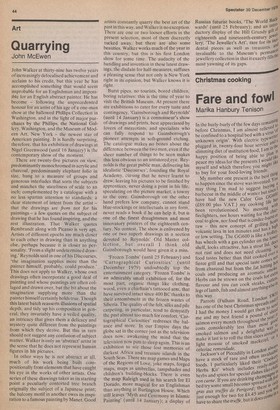Art
Quarrying
John McEwen
John Walker at thirty-nine has twelve years of iocreasingly delocalised achievement and acclaim to his credit, but this year he has accomplished something that would seem improbable for an Englishman and imposs ible for an English abstract painter. He has become — following the unprecedented honour for an artist of his age of a one-man show at the hallowed Phillips Collection in Washington, and in the light of major pur chases by the Phillips, the National Gal lery, Washington, and the Museum of Modem Art, New York — the newest star of American painting. It is hardly surprising, therefore, that his exhibition of drawings at Nigel Greenwood (until 16 January) is the contemporary show of the moment.
There are twenty-five pictures on view, predominantly monochromed in acrylic and charcoal, predominantly elephant folio in size, hung to a measure of groups and generous interludes that sorts the subjects and matches the stateliness of scale to an inch; complemented by a catalogue with a no less spartan attention to standards: a clear statement of intent from the artist — that the drawings are from not for his paintings — a few quotes on the subject of drawing that he has found inspiring, and the rest illustration. That Walker quotes Rembrandt along with Picasso is very apt. Artists of different epochs are much closer to each other in drawing than in anything else, perhaps because it is closer to personality. 'From a slight undetermined drawing,' Reynolds said in one of his Discourses, 'the imagination supplies more than the painter himself, probably, could produce.' This does not apply to Walker, whose own drawings often incorporate a good deal of painting and whose paintings are often collaged and drawn over, but the bit about the imagination supplying more than the painter himself certainly holds true. Though this latest batch reasserts illusions of spatial depth, and tidy up his composition in general, they invariably have a veiled quality, an intricacy that gives them a delicacy and mystery quite different from the paintings from which they derive. But this in turn should not suggest any confusion of subject matter. Walker is only an 'abstract' artist in the sense that he does not represent human figures in his pictures.
In other ways he is not abstract at all, much of his work being built compositionally from elements that have caught his eye in the works of other artists. One series of these drawings takes as its starting point a peculiarly contorted tree branch originally the subject of a Japanese print; the balcony motif in another owes its inspiration to a famous painting by Manet. Good artists constantly quarry the best art of the past in this way, and Walker is no exception. There are one or two looser efforts in the present selection, most of them discreetly tucked away, but there are also some beauties. Walker works much of the year in this country, but this is his first London show for some time. The audacity of the handling and invention in these latest drawings, the disdain for half-measures, suffuses a pleasing sense that not only is New York right in its ,opinion, but Walker knows it is right.
Burst pipes, no tourists, bored children, boring relatives: this is the time of year to visit the British Museum. At present there are exhibitions to cater for every taste and contingency. `Gainsborough and Reynolds' (until 14 January) is a connoisseur's show of drawings and prints, best appreciated by lovers of mezzotints, and specialists who can fully respond to Gainsborough's pioneer attempts in soft-ground etching. The catalogue makes no bones about the difference between the two men, even if the sheer number of things to be seen makes this less obvious to an untutored,eye. Reynolds is the great public man, delivering his idealistic 'Discourses', founding the Royal Academy, cursing that he never learnt to draw, leaving his pictures to be finished by apprentices, never doing a print in his life, speculating on the picture market, a towny to the core. Gainsborough on the other hand prefers low company, cannot stand blue-stockings or intellectuals in any form, never reads a book if he can help it, but is one of the finest draughtsmen and most innovatory printers of the eighteenth century. No contest. The show is enlivened by one or two superb drawings in a section devoted to Reynolds' Old Master colle ction , but overall I think old Gainsborough would have given it a miss.
'Frozen Tombs' (until 25 February) and 'Cartographical Curiosities' (until December 1979) undoubtedly top the entertainment category. 'Frozen Tombs' is an admirably small exhibition of, for the most part; organic things like clothing, wood, even a chieftain's tattooed arm, that have survived intact since 400 BC thanks to their entombment in the frozen wastes of Siberia. The quality of the felt, silks and pile carpeting, in particular, tend to demystify the past almost too much for comfort. 'Cartographical Curiosities' redresses the balance and more. In our Empire days the globe sat in the corner just as the television does now, awakening the mind that the television now puts to sleep again. This is an exhibition to stir those lost memories of darkest Africa and treasure islands in the South Seas. There are map games and Maps of the Regions of Love, joke maps, forged maps, maps as umbrellas, lampshades and children's building-blocks. There is even the map Raleigh used in his search for El Dorado, more magical for an Englishman than anything at Burlington House. Which still leaves 'Myth and Ceremony in Islamic Painting' (until 14 January); a display of Russian futurist books, 'The World liae}:. wards' (until 25 February); and an inttc`i ductory display of the Hill Grundy gift °I eighteenth and nineteenth-century loe:. lery, 'The Jeweller's Art', rare for its inctd" dental pieces as well as treasures, ant invaluable to the Museum's permanell jewellery collection in that it exactly fills the most yawning of its gaps.






















































 Previous page
Previous page